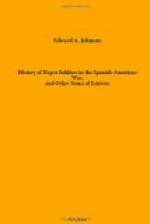“Be it Resolved by the Senate and House of Representatives of the United States of America, that in the opinion of Congress a public war exists between the Government of Spain and the Government proclaimed and for some time maintained by force of arms by the people of Cuba; and that the United States of America should maintain a strict neutrality between the contending powers, according to each all the rights of belligerents in the ports and territory of the United States.”
“Resolved further, that the friendly offices of the United States should be offered by the President to the Spanish government for the recognition of the independence of Cuba.”
The insurgents gained by this resolution an important point. It dignified their so-called insurrection into an organized army, with a government at its back which was so recognized and treated with. They could buy and sell in American ports.
[Illustration: General Antonio Maceo.]
General Antonio Maceo about this time was doing great havoc along the Spanish lines. He darted from place to place, back and forth across the supposed impassable line of Spanish fortifications stretching north and south across the island some distance from Havana, and known as the trocha. Thousands of Spaniards fell as the result of his daring and finesse in military execution. His deeds became known in America, and though a man of Negro descent, with dark skin and crisp hair, his fame was heralded far and wide in the American newspapers. At a public gathering in New York, where his picture was exhibited, the audience went wild with applause—the waving of handkerchiefs and the wild hurrahs were long and continued. The career of this hero was suddenly terminated by death, due to the treachery of his physician Zertucha, who, under the guise of a proposed treaty of peace, induced him to meet a company of Spanish officers, at which meeting, according to a pre-arranged plot, a mob of Spanish infantry rushed in on General Maceo and shot him down unarmed. It is said that his friends recovered his body and buried it in a secret place unknown to the Spaniards, who were anxious to obtain it for exhibition as a trophy of war in Havana. Maceo was equal to Toussaint L’Overture of San Domingo. His public life was consecrated to liberty; he knew no vice nor mean action; he would not permit any around him. When he landed in Cuba from Porto Rico he was told there were no arms. He replied, “I will get them with my machete,” and he left five thousand to the Cubans, conquered by his arm. Every time the Spanish attacked him they were beaten and left thousands of arms and much ammunition in his possession. He was born in Santiago de Cuba July 14, 1848.




